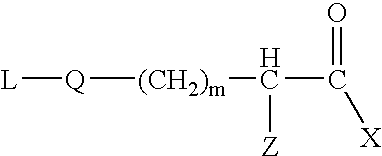Sterically hindered poly(ethylene glycol) alkanoic acids and derivatives thereof
a technology of ethylene glycol and alkanoic acid, which is applied in the field of watersoluble and nonpeptidic polymers, can solve problems such as problems such as problems such as the use of certain activated esters of peg, such as n-hydroxylsuccinimide esters, and achieve the effect of increasing the ability to control and manipulate the hydrolytic stability of polymer derivatives
- Summary
- Abstract
- Description
- Claims
- Application Information
AI Technical Summary
Benefits of technology
Problems solved by technology
Method used
Image
Examples
example 1
Preparation of mPEG-O—CH2CH(CH3)CO2H and mPEG-O—CH2CH(CH3)CO2NS (NS=N-succinimidyl)
[0088]Reactions:
1. Preparation of mPEG5000-O—CH2CH(CH3)CN
[0089]MPEG5000OH (4.0) g) and methacrylonitrile (1.0 ml) were stirred for three days at room temperature in a mixture of benzene (5.0 ml), dichloromethane (6.5 ml), and KOH (50% in H2O; 0.15 ml). To the resulting mixture was added 200 ml of 10% aqueous NaH2PO4. The mixture was stirred for 10 minutes before extracting with 200 ml of dichloromethane (100+50+50 ml). The organic phase was dried over MgSO4, concentrated, and precipitated into ethyl ether (50 ml). The precipitate was collected by filtration and dried under vacuum at room temperature to obtain 3.17 g of white powder.
[0090]NMR: (dmso-d6, ppm): 1.0438 (d, α-CH3); 2.55 (m, CH); 3.51 (br m, PEG-CH2CH2—O—).
2. Preparation of mPEG5000-O—CH2CH(CH3)CONH2
[0091]mPEG5000-O—CH2CH(CH3)CN (3.17 g) was dissolved in 14 ml of concentrated HCl and the solution was stirred three days at room temperature...
example 2
Preparation of mPEG-O—CH2CH2CH(CH3)CO2H and mPEG-O—CH2CH2CH(CH3)CO2NS
[0096]Reactions:
1. Preparation of CH3—O-PEG-O—CH2CH2C(CH3)(CO2H)2
[0097]Diethyl methylmalonate (9.6 ml) in 150 ml of dry dioxane was added dropwise to NaH (2.4 g) in 60 ml of toluene under argon. mPEG5000 mesylate (30 g) in 250 ml of toluene was azeotropically distilled to remove 150 ml of toluene and the residue was added to the above diethyl methylmalonate solution. After refluxing the mixture for 3–4 hours, it was evaporated under vacuum to dryness and dried in vacuo overnight. The dried material was then dissolved in 200 ml of 1N NaOH, the solution was stirred for 2 days at room temperature, and the pH adjusted to 3 with 1N HCl. NaCl was added to the solution to a concentration of about 15% and the mixture was then extracted with 350 ml of CH2Cl2 in several portions. The combined extracts were dried over Na2SO4, concentrated under vacuum and the product precipitated by addition of isopropanol / ether (1:1). The ...
example 3
PEGylation of Lysozyme with Activated α-Alkylalkanoic acids
[0103]To 4 ml of lysozyme solution (3 mg / ml) in 50 pH 6.5 buffer (50 mM sodium phosphate / 50 mM NaCl) was added 20 mg of the N-succinimidyl ester of the PEG alkanoate and the progress of the reaction at 22° C. was monitored by capillary electrophoresis at a wavelength of 205 nm. The area of the peak corresponding to unreacted protein was plotted against time and the half-life of the lysozyme in the PEGylation reaction was determined from that plot. The half-life using N-succinimidyl mPEG5K α-methylpropanoate was 100 minutes, while that of N-succinimidyl mPEG5K α-methylbutanoate was 120 minutes. The half-life for PEGylation using either of the non-α-alkylated analogues, mPEG5K N-succinimidyl propanoate or mPEG5K N-succinimidyl butanoate, was 30 minutes.
PUM
| Property | Measurement | Unit |
|---|---|---|
| average molecular weight | aaaaa | aaaaa |
| moleocular weight | aaaaa | aaaaa |
| average molecular weight | aaaaa | aaaaa |
Abstract
Description
Claims
Application Information
 Login to View More
Login to View More - R&D
- Intellectual Property
- Life Sciences
- Materials
- Tech Scout
- Unparalleled Data Quality
- Higher Quality Content
- 60% Fewer Hallucinations
Browse by: Latest US Patents, China's latest patents, Technical Efficacy Thesaurus, Application Domain, Technology Topic, Popular Technical Reports.
© 2025 PatSnap. All rights reserved.Legal|Privacy policy|Modern Slavery Act Transparency Statement|Sitemap|About US| Contact US: help@patsnap.com



